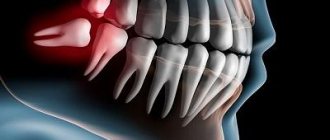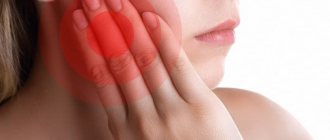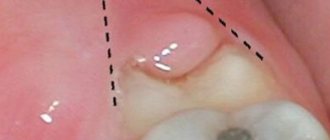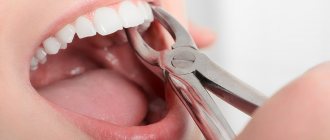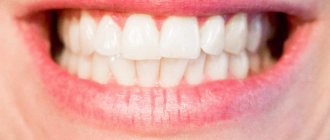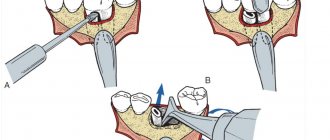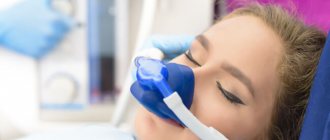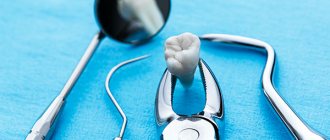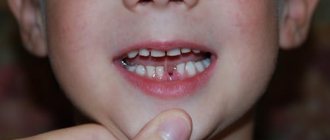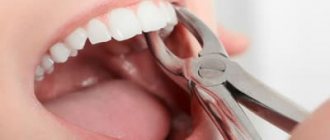Normally, a person grows 52 teeth over a lifetime: 20 milk teeth and 32 permanent teeth. Supernumerary teeth are “extra” dental units that appear in addition to some incisors, canines, premolars or molars. In various medical sources, the phenomenon is called hyperdontia, supradontia or polyodontia. A superset can include 1–2 teeth or reach several hundred dystopic structures, be true or false.
Supernumerary teeth: causes of anomaly
The main cause of polyodontia is a violation of the formation or development of tooth germs. Doctors are considering several theories for this phenomenon:
- Heredity – hyperdontia develops as a result of genetic abnormalities that can be transmitted from parents to children. In this case, the pathology should manifest itself in the patient’s closest blood relatives.
- Splitting of the root germ of the tooth in the embryonic period of development. Usually observed after the mother becomes ill during pregnancy. Characteristic of single supernumerary teeth (1–2 pcs.).
- Failure during the embryonic period of tooth formation with the formation of multiple dental buds (up to several hundred). It is observed when the mother lives in unfavorable environmental conditions, during treatment with dangerous drugs, taking drugs, or alcohol abuse.
In more rare cases, polyodontia develops as a result of odontoma, a benign tumor in the area of the jaw arches. The disease is typical for children and young people during the period of active growth of tooth germs. Such a tumor structure may contain several tens or even hundreds of highly deformed dentin-enamel formations.
Provoking factors in the prenatal period:
- malfunction of genes - primarily the Msx1 gene (responsible for the formation of tooth germs);
- viral infections;
- taking teratogenic and potentially dangerous drugs;
- smoking, drug use, alcohol use;
- poor environmental conditions;
- exposure to radiation - not only direct exposure, but also increased general background radiation in the place of residence/work.
Reference! Some scientists consider the presence of supernumerary teeth as an atavism. Thus, it has been scientifically proven that various species of the genus Homo could boast a set of teeth of 36–44 pieces. However, this theory does not explain in any way the appearance of multiple rudiments covering all spaces of the sky (a typical example is an Indian boy who had to remove 230 supernumerary units).
Where do excess teeth come from?
This dental anomaly in adults and children occurs in 7% of cases when visiting a dentist. Statistics say that 70% of patients with polyodontia may have only one extra tooth, 25% of people with pathology may have a pair of teeth, and 5% of patients with pathology may have three or more abnormally growing teeth. The reasons for this not entirely normal dental growth are not fully known, but there are several hypotheses:
- Atavism - our ancestors were programmed at the genetic level with six full-fledged incisors on each jaw, so they are trying to remind of themselves with such an anomaly in the development of teeth in modern humans.
- Intrauterine failure at the level of embryonic development of the fetus, when the tooth germ is split. The cause of the failure may be illness or bad habits during pregnancy, taking medications, poor environment, etc.
Since these are only assumptions, it is therefore difficult to say whether it is possible to prevent this anomaly or reduce the risk of its occurrence. Of course, we cannot influence genetics and nature, but maintaining a healthy lifestyle during pregnancy for the sake of the health of the unborn child is in any case necessary.
Symptoms of pathology
The main symptom is the presence of teeth beyond the natural set. They can have different positions, shapes and numbers. The process of teething of abnormal teeth is often accompanied by pain, fever, and inflammation of areas of the oral cavity. If measures are not taken in a timely manner, complications may develop:
- redness and swelling at the site of the impacted tooth;
- problems with chewing food and digestion;
- injuries to the mucous tissues of the oral cavity;
- violation of the position of the main teeth (dystopia) and the formation of malocclusion;
- various speech defects - mainly problems with the pronunciation of hissing sounds;
- loosening of adjacent normal teeth;
- deformation of the jaw bones.
In young children and adults, the pathology has its own nuances. They are associated with age-related characteristics of the body and affect the subsequent development of maxillofacial structures. Statistics on the spread of pathology in children and adults:
- 60% of cases are children and adolescents during the period of replacement of milk teeth with permanent ones;
- 35% of cases are adults;
- 5% of cases are small children during the period of growth of baby teeth.
Reference! Supernumerary teeth, as a rule, have a standard structure, sometimes with a smaller crown size. Less common are deformed formations of a teardrop-shaped, lumpy, chisel-shaped form.
Why is an impacted tooth dangerous?
Why doesn't the tooth erupt? Perhaps in childhood the patient had his baby teeth removed too early, which is why the molars initially formed incorrectly. Also, the cause of this phenomenon may be the displacement of neighboring molars in relation to their physiological position.
Impacted teeth can be called a time bomb, since sooner or later they can provoke the following problems:
- Caries;
- Inflammation of the gums around the area of the unerupted tooth;
- Curvature of neighboring teeth due to constant pressure;
- Vomiting sensations, swelling of soft tissues, numbness of the face due to the effect on nerve endings;
- Periodontitis;
- Periodontal disease;
- Bite disorders.
Features of polyodontia in children
Possible symptoms of hyperdontia in childhood:
- intrauterine formation of teeth (a child is born with several teeth);
- the appearance of teeth in the first months, weeks and even days of life;
- delayed eruption of baby teeth.
This has unpleasant consequences:
- problems with feeding the baby - he does not latch onto the nipple well and sucks weakly;
- swelling of the mucous tissues can spread to the nasal area and cause breathing problems;
- poor closure of the dental arches causes severe salivation;
- a prolonged increase in temperature to 38C is possible.
Hyperdontia is especially harmful during the period of speech formation. Teeth located outside the general row prevent the tongue from taking the correct position when pronouncing most consonant sounds. Without eliminating the pathology, any speech therapist will be powerless.
In addition to true hyperdontia, children (less often adults) can develop the so-called false form of the disease. It is characteristic of the period of tooth change and develops during the eruption of molars next to the milk teeth that have not yet fallen out. This is a fairly common phenomenon that usually goes away on its own as the dentition finally forms. In some cases, orthodontic treatment may be required.
Polyodontia is an abnormal number of teeth.
In medicine, this disease is often called hyperdontia, and “extra” dental elements are called supernumerary teeth. Research is still being conducted into why this pathology occurs. Most scientists associate it with disturbances in the formation of tooth germs.
Nature provides that a person grows no more than 20 milk teeth and 32 permanent teeth in a lifetime, but exceptions occur, and in our time quite often. According to statistics, on average, dental anomalies occur in 2% of the world's population, most often in men.
In 2014 alone, two operations were performed, in one of which 80 teeth were removed, and in the other, a record 232 teeth. Until this time, the maximum figure was 37 teeth.
The most common hyperdontia (anomaly in the number of teeth) is an anomaly of the upper incisors. Supernumerary teeth are less common among the lower incisors and in other parts of the jaw. They can come in a wide variety of shapes and sizes. These are usually small, cone-shaped teeth.
Extra teeth lead to deformation of the dentition, so it is recommended to remove supernumerary elements. Another reason for removal is that most patients with this pathology have a lisp.
The formation of extra teeth is quite common today. According to statistics, 70% of patients have only one extra incisor, in 25% of cases – 2 supernumerary elements, and only 5% of all patients have 3 or more teeth during examination.
Features of polyodontia in adults and adolescents
In adults, after complete replacement of complete teeth, the presence of additional units can lead to additional pathologies:
- chronic rhinitis, sinusitis when the wall of the maxillary sinuses is perforated by the roots of supernumerary impacted structures;
- interdental caries - due to teeth fitting too closely to each other.
Retention and dystopia
Adults are characterized by 2 main types of supernumerary teeth:
- Dystopic teeth are the name given to teeth with deviations in the direction of growth. The peculiarities of the formation of supernumerary units very often lead to dystopia. This is due to the fact that the space on the dental arch line is limited, and the roots of normal teeth simply push the “intruder” towards the cheek or palate.
- Impacted teeth – impaction occurs when a tooth loses its growth impulse and remains embedded in the jawbone. Impacted teeth can cause the adjacent normal teeth to become loose and cause them to shift and change the bite. Often cause pain.
On a note! According to statistics, hyperdontia accounts for up to 2% of cases of dental problems. Of these, 70% are associated with the appearance of single supernumerary teeth, 25% with a couple of such formations, and only in 5% complex multiple complexes of 3–4 or more teeth can be found.
Consequences of polyodontia disease
Polyodontia in humans can often be the cause of retention. This is a phenomenon in which normal teeth are unable to erupt due to the interference of supernumerary teeth. The former may remain in the jaw or take an abnormal position.
In addition, even if the complete incisor grows before the supernumerary one, the latter will be able to displace it. This will lead to the person being unable to chew food normally. And if several extra incisors grow at once, they can cause the loss of permanent teeth.
Diagnostic methods
The main indication for diagnosis is the presence of an “extra” tooth in the patient’s oral cavity or obvious signs of its eruption (painful tubercle or swelling in the gum or palate). All of these signs can be identified through a routine visual examination, during which the dentist evaluates the condition of the oral cavity. To confirm the diagnosis and carry out differential diagnosis, an X-ray examination is performed - an orthopantomogram. If it is necessary to examine the dentition in several planes, computed tomography (CT) is additionally prescribed.
On a note! The patient may not be aware of the presence of impacted supernumerary teeth. In this case, hyperdontia is detected only by the results of an X-ray or CT scan of the maxillofacial region.
Impacted and dystopic teeth
Impacted tooth
- this is a tooth that has already fully formed, but cannot fully erupt, since it is partially or completely covered by either the gums, the jaw bone, or another tooth located nearby. As a result, such a tooth gets stuck in the jaw, the gums become swollen and inflamed, causing severe pain.
This is one of the most common dental anomalies. The most common impacted “wisdom teeth” are the eights in the lower jaw. In fact, this is why wisdom teeth are most often removed. While they are in their rudimentary, “dormant” state, they do not cause pain or discomfort, but if they begin to erupt incorrectly, they can not only provoke inflammation, but also damage other teeth.
In this regard, dentists recommend removing the impacted tooth immediately after it begins to cut, without waiting or delaying. Retention of a wisdom tooth before age 25 is not considered an anomaly.
, but normally after 25 these teeth still erupt. Sometimes they are removed at an early age to prevent them from erupting in the future.
Often, an impacted tooth is also called a dystopic tooth, in which it is displaced inside the gum and grows into the cheek, palate or gum, and not as it should.
Do supernumerary teeth need to be removed?
There is no clear answer to the question of what to do with “extra” teeth. Much depends on the shape, position and quantity. The following are subject to mandatory removal:
- baby teeth that interfere with normal growth and formation of permanent teeth;
- strongly dystopic structures - located on the palate or at a large angle to the lateral side of the gums;
- impacted formations that put pressure on the adjacent roots of normal teeth and provoke periodic inflammatory processes of soft tissues.
If the additional tooth does not cause discomfort and does not disrupt the development of the dentition, removal may not be necessary. Moreover, such a superset can play the role of a strategic reserve in case of damage to nearby normal teeth.
How does the removal work?
The removal procedure can be simple or complex. In the first case, the doctor is dealing with a fully erupted tooth, the root of which is not intertwined with the surrounding structures. Simple removal steps:
- The oral cavity is prepared - treated with antiseptics, anesthesia is given.
- Grasp the crown with forceps (in some cases, an additional incision of the mucous tissue is required to facilitate access).
- The elevator destroys the retaining ligaments.
- The root is freed and the tooth is removed.
- Clean the hole from tooth fragments and bones.
- Apply stitches (if necessary) and a healing bandage.
Complex extraction is prescribed in the case of impacted, semi-impacted or dystopic teeth with complex root shapes. The procedure is carried out with a deep incision of soft tissues, in especially severe cases - with opening of the jaw bone to gain access to the roots. The latter option is relevant for deep bone occurrence, position in close proximity to the cranial sinuses and orbits, as well as for irregularly shaped roots and a high risk of damage to complete teeth. A complex removal operation is performed by a dental surgeon.
How is impacted wisdom tooth removed?
The operation to remove an unerupted “eight” is quite complex and sometimes lasts up to three hours. The smaller the part of the tooth that appears above the surface of the gum, the more time and effort the surgeon will have to spend.
- First of all, the doctor injects anesthesia - without it, manipulation is impossible.
- He then makes an incision into the gum and lifts the flap to gain access to the bone.
- Using a special instrument, the surgeon makes holes in the bone tissue. If the tooth is large enough, it is sawed down and removed piece by piece.
- The doctor places medicine into the resulting hole and stitches the wound.
–>
Orthodontic treatment
Depending on the situation, it is used after tooth extraction or instead of it. In children, it is used to stimulate the loss of baby teeth and eliminate false hyperdontia, as well as to facilitate and accelerate the eruption of a normal set. In addition, orthodontic treatment with the installation of braces, mouth guards, dental plates or other auxiliary structures can straighten crooked teeth and return them to their proper place.
Before prescribing treatment, the dentist carefully evaluates the condition of the complete and supernumerary structures and, depending on the overall picture and prognosis for the future, can use both formations or leave the strongest and most durable tooth (not necessarily complete).
Indications for removal of an impacted tooth
Removing impacted eights is a serious surgical procedure. The more complex the operation, the longer it takes, and the more severe the anesthesia must be. Indications for removal of impacted teeth include the following factors:
- an impacted tooth interferes with the correct placement of other teeth in the dentition
- after orthodontic treatment to correct the bite, since an impacted tooth can disrupt an already corrected bite
- the appearance of a cyst. In this case, it is necessary not only to remove the impacted tooth, but also the cyst. To remove a cyst, it is often necessary to remove the pulp from an adjacent healthy tooth.
- if the impacted tooth is in close contact with the adjacent tooth
- during the formation of a gingival hood
- the development of an inflammatory process around the impacted tooth, which can lead to an abscess.
Types of teeth with hyperdontia
Supernumerary teeth in hyperdontia can be divided into several types according to their location in the mouth:
- Spiny. May form on the upper jaw. Localization - between the central and lateral incisors, within the immediate limits of the main dental arches. They are called spiky because of the presence of very sharp ends.
- Additional premolars. They grow from the cheek side within the normal molar units of the dentition.
- Extra fangs. These grow on the upper jaw, in 99% of cases - on the side of the cheek and lip.
- Additional premolars. The localization area of these additional teeth is the lower jaw, on the cheek side.
Additional and primary teeth may fuse. There are 4 types of such merger:
- Bedding. The enamel of both teeth, twin neighbors, grows in the form of tubercles over the entire tooth surface.
- Root merge. The crown parts are located separately, but the roots are fused together.
- Coronal fusion. The root system of each tooth is separate, but the crown part is fused and has one common enamel “shirt”.
- Complete fusion of twin teeth. The crowns, which have a common enamel coating, and the roots are fused together.
What is hyperdontia
According to the International Classification of Diseases (ICD-10), the diagnosis of “supernumerary teeth” is assigned code K00.1. When answering the question about what hyperdontia is, it should immediately be noted that normally a child should have 20 milk units, and after the formation of a permanent dentition their number will increase to 32. With the development of hyperdontia, a person develops supernumerary, that is, extra elements. Most often, this diagnosis is made towards the end of the formation of the mixed dentition, when most of the incisors, canines and molars have erupted.
Sometimes extra teeth grow along with the baby incisors and canines. The pathology is more often observed in males, while in girls and women it is diagnosed in 35% of cases of the total number. In 85% of cases, 1-2 more teeth appear in the mouth, but other patients may experience the appearance of 3 or more extra elements. Moreover, they can be located outside the jaw arch, including in the lingual area and on the hard palate1.
With hyperdontia, a person develops extra teeth
Usually, excess elements erupt near the incisors of the upper jaw; less commonly, the anomaly occurs in the lower jaw. At the same time, the teeth themselves may have a deformed shape; they often differ in structure and color. Many of them take on the shape of a cone, remain incompletely developed, dystopic and impacted.
